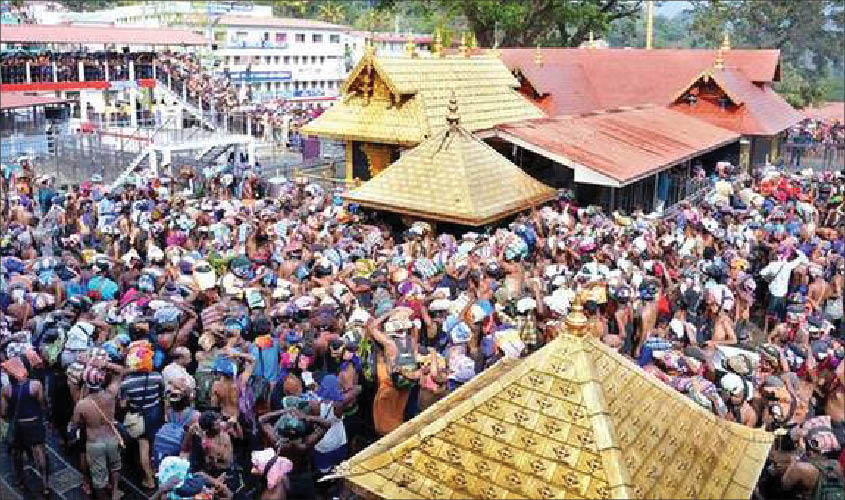It has been a few days since I got back to Delhi and because it was a conscious decision to keep away from the escalator of over-saturated, over-stimulated news mass-produced in this digital age making one, oddly so, further wrapped up into a bubble, I indeed was taken aback that the Sabarimala issue had taken another turn. The Board Members of the Temple decided that they should defer to the Supreme Court’s orders, stating that women of all ages would be free to enter the shrine, breathing the same sanctified air while having Darshanof Lord Ayyappa and offering their prayers for him to better their lives.
It was, if my mind is not fogged out, on 28 September when all hell broke loose, following the Apex Court’s ruling that the ban of women aged between 10 and 50 had been lifted. In plain speak, pms-ing, perioding, ovulating, menopausing women all could bow their heads in front of Lord Ayyappa. Just a couple of months ago, a Kanaka Durga, who had managed to trek up to the hilltop shrine without a whisper of make-up, but of course, was, after having gotten a “forced audience” with the deity, on returning home was beaten up by her mother-in-law for the sacrilege, thrown out of the house by her husband and her brother’s door remained firmly shut even after her persistent knocking. Last heard, she after hospitalisation was living in a shelter homing abandoned women.
I, however, have liberally let the ink flow over so much space and still not covered the ground that I set out to tread! Towards the end of last September and all of October every TV channel in Bharat had, thick in the mood of over-consumption and over-indulgence, turned itself up and down, reeling how the police force had been inducted to escort women to pay their obeisance at Sabarimala, how the Supreme Court had no say in the matter, how no matter our Kalpana Chawlas, India still continued to treat women as a second sex, always standing last in the line despite our Constitution maintaining all citizens were equal… The point’s been made, so must hasten to push forth what I intended to some 20-something minutes ago. With the temple’s priests and all men in the vicinity taking to the streets to barricade any woman trying to catch even a blink-and-one-shall-miss-him glimpse of the Divine Being, one still is at sea how the, à la Hindi film, instantaneous change of heart, the 180-degree turnaround after the level of hullaballoo, the quantum of pandemonium that women now onwards, are accorded an open-armed welcome at the shrine. When the outcry, in a few short hours of the Supreme Court declaring that the temple gates were to be opened to women, reached hubble-bubble heights, ignorant me had to take out my newly-needed reading glasses—so that my older eyes could not miss out anything—and started micro-googling, deaf to the rumbling of a tummy that had gone breakfast-less with the clock pointing to lunch hour.
So goes the story: Ayyappa was born out of the union of Shiva and Vishnu. Vishnu becomes Mohini, taking on a female form. Mahishi, a she-demon was out to wrought havoc and ruin; she, with her blood-thirsty fangs, on the rampage. Mahishi was invincible since Lord Brahma had declared that only a child born of Lord Vishnu and Lord Shiva could slay her. To chop, chop, chop a most interesting piece of mythology lest one is left mid-air with no remaining landing space: after a fierce battle Ayyappa killed the demoness. From within her emerged a beautiful maiden, who because of a curse, had been entrapped in Mahishi’s satanic body. The heavenly damsel immediately fell in love with Ayyappa who had decided to remain celibate. He told Malikappurathamma that he would be devoting his life to the Divine. A temple was built for him by the Architect God, Vishwakarma. Ayyappa promised the love-struck lady that he would marry her the day devotees stopped seeking him to bestow his blessings. A small temple of her’s stands nearby the Sabarimala sanctum.
Now to come to the fact of the matter, though I am quite sure that I shall earn the ire of many a friend, to the extent that I might, temporary so hopefully, be shown the door if I land up on a shivery cold morning for a cup of chai. Admittedly—definitely so—there is segregation and subjugation of women in our society. Women, even if financially independent, have their voice muffled and more often than not muted. Once married, generally so, (see how I have to keep qualifying so as to not have men roasting me alive!) the wife has to take on all the customs of her husband’s family, remembering to forget her own prior to acquiring the “Mrs” tag. Unswerving misogyny pursued with an alive and kicking doggedness taken as an “unwritten law” by someone heading the household. However, returning finally, for a short bit to Lord Ayyappa. In this case, it is no rejection of women. His story is that of a Brahmchaari who wishes to pursue his meditation undisturbed; conscious of Malikappurathamma, devotedly setting up home next to him, but carrying on with his steadfast contemplation. There is, is there not, something known as tradition, custom which is unrelated to any gender bias?! Rituals that are inexplicably intertwined with mythology…
A Memory Flash: my Nani never would set foot in her rasoi ghar with her slippers on nor would allow anyone to. In reflex, they’d be shoe-horned off. An unquestioned observance, a practice, a custom that applied to, one and all; my grandfather having to remove his sandals many feet away from the kitchen due to his forgetful nature…
Dr Renée Ranchan writes on socio-psychological issues, quasi-political matters and concerns that touch us all

